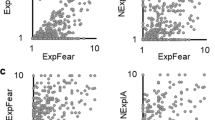Abstract
An analogue setting for assessing dental fear involving a videotaped simulated dental operation was evaluated in terms of its capability of eliciting differential physiological arousal (Palmer Sweat Index) between high- and low-fear subjects, identified by self-reports of dental fear. Results showed high-fear subjects to exhibit significantly greater palmar sweating than did low-fear subjects, females to respond more than males, and a differential response across groups at different points during the simulated operation. High-fear subjects also gave verbal reports of greater physiological arousal and general anxiety while viewing the operation than did low-fear subjects.
Similar content being viewed by others
References
Agras, S., Sylvester, D., and Oliveau, D. The epidemiology of common fears and phobias,Comprehensive Psychiatry 1969,10 151–156.
Bernstein, D. A. Situational factors in behavioral fear assessment: A progress report.Behavior Therapy 1973,4 41–48.
Bernstein, D. A., and Kleinknecht, R. A. Multiple approaches to the reduction of dental fear.Journal of Behavior Therapy and Experimental Psychiatry, in press, 1982.
Bernstein, D. A., Kleinknecht, R. A., and Alexander, L. D. Antecedents of dental fear.Journal of Public Health Dentistry 1979,39 113–124.
Corah, N. L., and Pantera, R. E. Controlled study of psychologic stress in a dental procedure.Journal of Dental Research 1968,47 154–157.
Corah, N. L., and Salmonson, R. J. Psychologic response to a simulated dental procedure as a function of proximity to an actual dental appointment.Journal of Dental Research 1970,49 438–441.
Early, C. E., and Kleinknecht, R. A. The palmar sweat index as a function of repression-sensitization and fear of dentistry.Journal of Consulting and Clinical Psychology 1978,46 184–185.
Eysenck, H. J., and Eysenck, S. B. C.Eysenck Personality Inventory. San Diego, Calif.: Educational and Industrial Testing Service, 1963.
Ferreira, A. J., and Winter, W. D. Age and sex differences in the palmar sweat print.Psychosomatic Medicine 1965,27 207–211.
Friedson, E., and Feldman, J. J. The public looks at dental care.Journal of the American Dental Association 1958,57 325–335.
Gale, E. N. Fears of the dental situation.Journal of Dental Research 1972,51 964–966.
Geer, J. H. The development of a scale to measure fear.Behaviour Research and Therapy 1965,3 45–53.
Haywood, H. C., and Spielberger, C. D. Palmar sweating as a function of individual differences in manifest anxiety.Journal of Personality and Social Psychology 1966,3 103–105.
Johnson, J., and Dabbs, J. Enumeration of active sweat glands: A simple physiological indicator of psychological changes.Nursing Research 1967,16 273–276.
Kleinknecht, R. A., and Bernstein, D. A. Assessment of dental fear.Behavior Therapy 1978,9 626–634.
Kleinknecht, R. A., and Bernstein, D. A. Fear assessment in the dental office. In B. D. Ingersoll and W. R. McCutcheon (Eds.),Clinical Research in Behavioral Dentistry Morgantown: West Virginia University Press, 1979, pp. 16–34.
Kleinknecht, R. A., Klepac, R. K., and Alexander, L. D. Origins and characteristics of fear of dentistry.Journal of American Dental Association 1973,86 842–848.
Kleinknecht, R. A., Bernstein, D. A., and Spofford, M. Analogue assessment of dental fear. Paper presented at the 12th Annual Meeting of the Association for Advancement of Behavior Therapy, Chicago, November 1978.
Lang, P. J. Fear reduction and fear behavior: Problems in treating a construct. In J. M. Schlien (Ed.),Research in Psychotherapy, Vol. 3. Washington, D.C.: American Psychological Association, 1968, pp. 90–102.
Lautch, H. Dental phobia.British Journal of Psychiatry 1971,119 151–158.
Melamed, B. G. Behavioral approaches to fear in dental settings.Progress in Behavior Modification 1979,7 171–203.
Melamed, B. G., and Siegel, L. J. Reduction of anxiety in children facing hospitalization and surgery by use of filmed modeling.Journal of Consulting and Clinical Psychology 1975,43 511–521.
Melamed, B. G., Hawes, R. R., Heiby, E., and Gluck, J. The use of filmed modeling to reduce uncooperative behavior of children during dental treatment.Journal of Dental Research 1975,54 797–801.
Weisenberg, M., Kreindler, M. L., Schachat, R., and Werboff, J. Pain: Anxiety and attitudes in Black, White, and Puerto Rican Patients.Psychosomatic Medicine 1975,37 123–135.
Author information
Authors and Affiliations
Rights and permissions
About this article
Cite this article
Brandon, R.K., Kleinknecht, R.A. Fear assessment in a dental analogue setting. Journal of Behavioral Assessment 4, 317–325 (1982). https://doi.org/10.1007/BF01341227
Accepted:
Issue Date:
DOI: https://doi.org/10.1007/BF01341227




